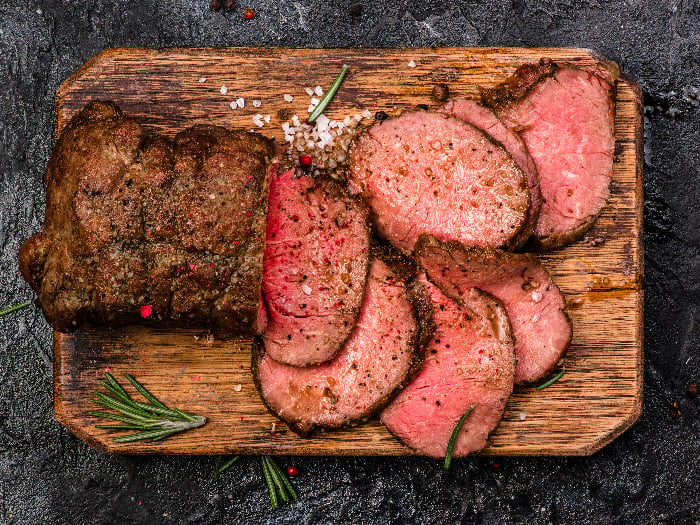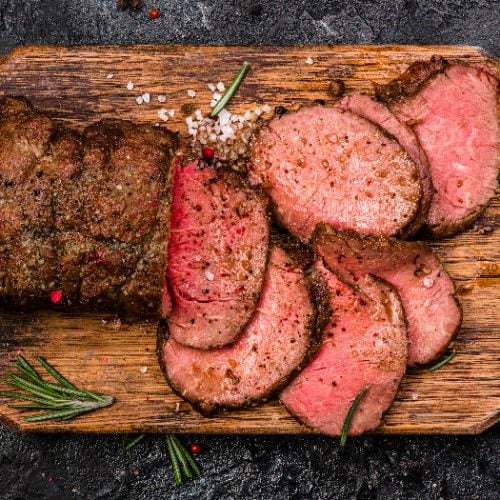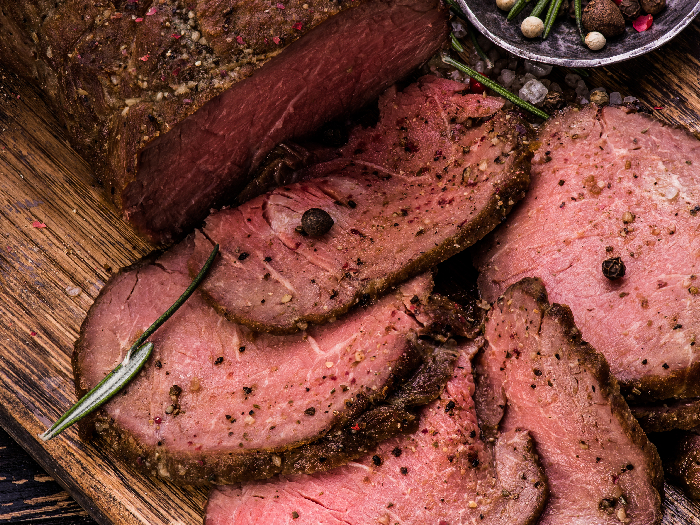Beef tenderloin is the most prized cut of beef and certainly, the most expensive. The tenderloin is perhaps so named because it is the most tender part of the beef. The best of beef steaks come from the tenderloin, including the T-bone steak, porterhouse steak, and the posh filet mignon. It’s the perennial holiday favorite, special enough for the occasion, perfect for the dinner centerpiece, and capable of feeding a party.
Because it is a prime cut, you must take care when buying the meat. It is equally important to respect it, understand where it comes from, how it should be cooked and what you can do to enhance the flavor.
What is Beef Tenderloin?
The beef tenderloin is the muscle along the backbone of the cow. It is an oblong muscle known as the psoas major. It extends along the rear portion of the backbone, lying directly behind the kidney. It extends from the thirteenth rib to the hip bone. It is a muscle that does not get much exercise or lies in a weight-bearing region. Hence, the fibers are very small, which is why it is extremely tender. It is a long muscle, about 24-inches long.

Beef tenderloin is incredibly tender with wonderful flavor. Photo Credit: Shutterstock
Buying Tenderloin
You can buy the whole tenderloin or get smaller steaks. When it comes to tenderloin cuts, the style of butchery can differ depending on where you are. In France, the steak will be butchered as per the muscle division. The filet mignon lies in the front, the châteaubriand is in the middle, and the bifteck lies at the rump end. In America, the three cuts are known as the butt, the center-cut, and the tail.
Peeled Vs Unpeeled: When buying the whole tenderloin, you will get the option of ‘peeled’, ‘unpeeled’, and ‘pismos’. This refers to the way the meat is butchered from the cow. ‘Peeled’ cuts have the fat and connective tissue removed. It is a convenient option if you don’t have the knife skills and want something ready to cook. The unpeeled cuts come with the fat and connective muscles. It is usually cheaper than a peeled cut. However, you need to remove the fat and clean the meat before cooking. Pismos or PSMOs stands for peeled, skinned, and the side muscles left on.
Selecting the right cut: The best way to ensure you are buying the best quality beef is to look for the USDA ‘Prime’ label. The USDA prime beef has some amount of fat streaking through the muscle, which gives it a delicious flavor. This is prime meat that is carefully selected and labeled. Unfortunately, only about 2 percent of the meat is labeled ‘Prime’, which means that it is not as easily available and is quite expensive. A cheaper and more widely available option is the USDA ‘Choice’ label. It is still quite delicious.
Where to buy: Ideally, you want to get your meat from a specialty butcher shop. They are the best place to buy the meat as they are more likely to stock good quality beef. They will also cut the meat as per your requirement. Apart from valuable advice, a good butcher will also tie the tenderloin for you. Alternatively, you can buy it from the meat counter of a grocery store. Usually, you will get pre-packaged steaks at the store. You can also mail order USDA prime beef.
Best Way to Cook Beef Tenderloin
Despite its five-star status, the beef tenderloin is rather short on flavor. This is because it does not have any bone or fat marbling through it. In addition, the meat cooks quickly. Given the expense and the tenderness of the meat, you must cook it carefully. Fortunately, it cooks quickly and the preparation is actually quite easy. There are just a few factors you should remember:
Tying the meat: When cooking a whole tenderloin, it is important that you tie the meat. When the skin is removed from the meat, it starts to flatten and lose shape. It also tends to twist and curl during cooking. In addition, it is an irregularly shaped cut that tapers at one end (the tail). Untied, the narrow ends will cook before the thicker side. Tying the meat is essential to ensure that the meat holds its shape and cooks evenly throughout its length. You can do this with kitchen twine or a butcher string. When tying the meat, make sure that the string presses firmly without being too tight. The string will lose its grip if it is too loose as the meat shrinks while cooking. If you tie it too tight, you may end up cutting the meat.
Searing the meat: Searing ensures that the juices are locked into the meat and it gives a beautiful crust. Make sure the meat is at room temperature. Pat dry the meat before putting it in the pan to remove any moisture. Once the meat is seared, it can finish cooking in the oven.
Seasoning the meat: Since the tenderloin does not contain a lot of flavors, seasoning is essential. Underseasoned meat is quite unappetizing.
Bringing flavor: Since the meat does not have much flavor of its own, marinating is one way to put flavor in the meat. This is your flavor base and you can choose a number of combinations. Salt and pepper seasoning is the simplest. Other classical additions like garlic also go well. Herbs like rosemary, oregano, and thyme go well with tenderloin.
Cooking temperature and duration: Because the tenderloin is so tender, it will harden up and become dry if overcooked. This is why the cooking temperature is so important. The ideal temperature is 120°F-125°F for rare, 130º to 135º for medium-rare, and 140º to 145º for medium. Keep in mind that the meat will keep cooking after you take it off the heat.
Resting the meat: Do not cut the meat immediately after it is cooked. It is very important to rest the meat when it’s done cooking. This allows the meat to finish cooking, the temperature to equalize, and for the fibers to reabsorb the internal juices. If you do not rest the meat, the juices will ooze out when you slice the meat.

Pepper-Roasted Beef Tenderloin Recipe
Ingredients
- 4-5 pound beef tenderloin
- 2 tsp coarse salt
- 2 tsp black pepper coarsely grounded
- 1 tsp white pepper grounded
- 2 tbsp crushed garlic
- 1/2 cup Worcestershire sauce or
- 1/2 cup balsamic vinegar
- 3 sprig rosemary
- 3 sprig thyme
- 1 tsp olive oil
- 1/2 stick butter
Instructions
- Put all the ingredients except the beef and the butter in a sealed bag. Now put the tenderloin inside and move it around so that it is completely covered in the marinade. Seal the bag and let it marinate for at least 2 hours.
- Put the oven at 450 degrees. Heat an oven-proof skillet to high heat on the stove.
- Take out the meat and get it ready for searing. Make sure the meat is at room temperature. To sear, put the meat on the hot pan. It should sizzle and start searing immediately. Turn it around to make sure that all sides are seared.
- Once the meat is seared on all sides, take it off the heat. Put the butter in the pan and as it melts, move the tenderloin in it so that it coats the meat.
- Transfer the pan to the oven and let it roast. Check the temperature after about 5 minutes. Remember to not overcook the meat.
- Let the meat rest for at least 15 minutes in a warm place. Thinly slice and serve.

Notes
Connect With Us
If you have tried this recipe, we would love your feedback in the comments section below. And while we can’t taste it, we would love to see how it turned out! You can connect with us on Facebook or Instagram and tag your picture with #organicfactsrecipes. [1] [2]
Do you wish to share your winning recipes with us? Please click here and fill in the details to get started.

